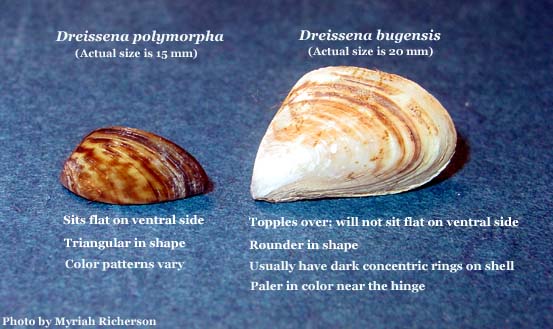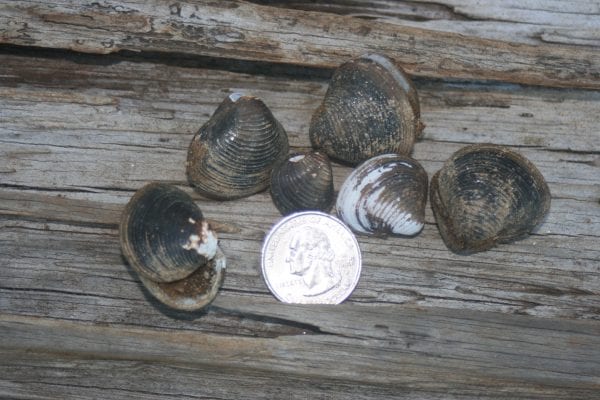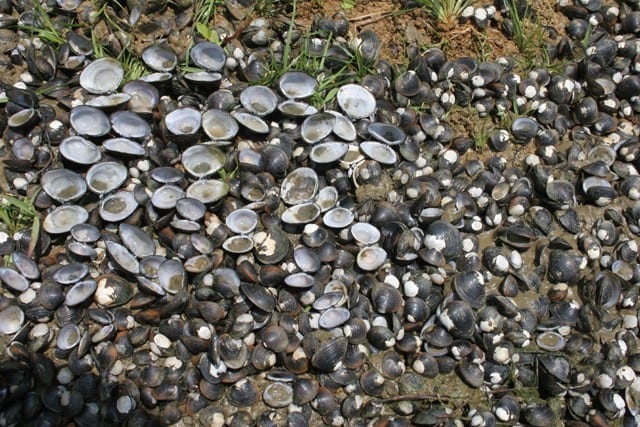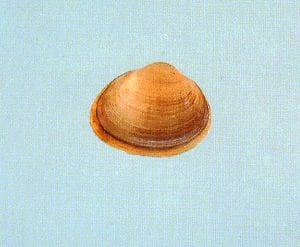Fisheries

Pond owners have sometimes intentionally and sometimes accidentally introduced freshwater clams or mussels into their recreational ponds. While not all species cause problems, the invasive Asiatic clam, Corbicula, can multiply and filter out the important phytoplankton. Control of established populations involves partial draining of the pond. The best control is to not introduce clams to the pond.
Sometimes our management decisions have unintended consequences that undo positive things we are trying to achieve. This is especially true when we add new species to a system such as a recreational fish pond.
In managing recreational largemouth bass and bream ponds, stocking additional forage species should only be done after careful consideration of the potential negative consequences. While the intention might be to improve growth or numbers of a particular fish, stocking alternative forage can lead to a dramatic imbalance in the pond system, which leads to poor fish growth and other management problems. A good example of this is adding freshwater clams, particularly Corbicula or Asiatic clam (Corbicula fluminea), to a pond to try to improve the growth of redear sunfish (Lepomis microlophus). Redear sunfish are also known as shellcrackers because they often eat snails and small clams.
One might logically think that adding clams to a pond would be beneficial to shellcrackers; however, these mollusks can become so abundant in the pond that they remove much of the algae. When this happens, the productivity of the entire pond goes down, including the growth and abundance of the fish.
There are four groups of freshwater clams or mussels in North America: fingernail clams, freshwater pearly mussels in the order Unionidae and often referred to as unionids, zebra mussels (Dreissena spp.), and Corbicula. Both fingernail clams and unionid mussels are groups native to North American streams and ponds, while zebra mussels and Corbicula are invasive species from Asia and Europe.
Fingernail Clams
Fingernail clams (Figure 1) are small mollusks commonly found in natural and human-made ponds. The largest species in this family may reach 1 (one) inch in diameter. Fingernail clams are common food for many fish, including redear sunfish. These small clams pose no threat to pond management, but it is likely that they are already in the pond and adding more will do little good.
- Figure 1. Fingernail clam (Photo courtesy of the Illinois Natural History Survey)
- Figure 2. Unionid freshwater pearly mussel—paper pondshell (Photo courtesy of the Illinois Natural History Survey.)
Freshwater Pearly Mussels—Unionids
Unionid mussels (Figure 2) are considered to be some of the most interesting water animals. Some can grow to a very large size, sometimes exceeding 12 inches in diameter. Some of these large mussels have been harvested to make buttons and to form the “seed” that is placed inside the Asian saltwater pearl oysters to allow the formation of the cultured pearl. Some larger unionids found typically in large streams make colorful pearls in an array of shapes. While many species are quite common, native freshwater mussels include some of the rarest and most endangered species found in streams. Unionids have parasitic larvae called glochidia that attach to the gills and skin of fish and some frogs and salamanders. The larvae live on the fish until they transform, drop off, and burrow into the pond or stream bottom to become free-living, filter-feeders. These mussels are most likely introduced into fish ponds while they are attached as larvae to fish.
Unionids are not a significant food source for most pond fish because the mussels are buried when they are small and they are too large as adults. However, unionid mussels are food for some species of wildlife such as muskrats, beavers, racoons, and otters. Piles of shell on the bank are an indication that the pond has both the mussel and a wildlife species that eats them.
Only a few species of common unionid mussels thrive in pond conditions. Those that thrive can develop large beds, but they usually do little harm to a pond. It is possible, though, that they will reach high enough numbers to filter the pond water, reducing the algae and leading to reduced growth of the fish. To prevent unionid mussels from getting into a pond, do not stock the adult mussels or bring in wild fish from streams and reservoirs that may be infected with glochidia. It is normally not necessary to kill or remove the mussels if they do become established in a pond. To completely eliminate unionid mussels from a pond, drain the pond completely and leave it dry for several weeks.
Invasive Mollusks—Zebra Mussels and Corbicula (Asiatic Clams)
The two other groups of freshwater clams are nonnative, invasive species that have caused billions of dollars of damage in public waters. Zebra mussels and Asiatic 2 Alabama Cooperative Extension Systemclams clog water intakes, reduce native mussels, and generally damage ecosystems wherever they become established in high numbers.
Zebra Mussels

Figure 3. Zebra and quagga mussels (Photo courtesy of the U.S. Geological Survey.)
Zebra mussels have a characteristic dark-and-light striped shell and the ability to attach themselves to nearly any hard surface such as pilings, pipe walls, the bottom of boats, or even other clams. There are two species of mussels, the zebra mussel proper (Dreissena polymorpha) and the quagga mussel (Dreissena bugensis), that make up what are collectively called zebra mussels. (See Figure 3.) These invaders are thought to have reached the United States via shipping into the Great Lakes during the 1980s. Since that time, zebra mussels have spread throughout the upper midwestern United States and southern Canada. While they have been found in the Southeast, zebra mussels have not established the damaging numbers seen in the Great Lakes states. Zebra mussels are normally accidentally moved from one basin to the next, attached to boats or as larvae in bilge water. Unfortunately, there have been cases where people intentionally stocked zebra mussels into small lakes to make the water clearer for diving and swimming. If you see something that appears to be a zebra mussel, report it to your local Extension office or State Fisheries district biologist. Under no circumstances should zebra mussels be intentionally moved from one water body to another. Such stocking is illegal under both state and federal law.
Corbicula

Figure 4. The Asiatic clam, Corbicula fluminea
Corbicula (Figure 4) cause the most problems in private ponds of any mussel found in the United States. They have been in North America since the early 1900s when they arrived from Asia likely in the ballast of ships, although there is some evidence that they were intentionally released. These small clams have spread all over the continent causing billions of dollars of damage. One study conducted in the early 1990s found that Corbicula caused more than a billion dollars of damage in the United States in one year alone.
This clam thrives in flowing and standing water with sufficient calcium and productivity. With typical management practices of liming and fertilization, we create a perfect habitat for Corbicula in recreational fish ponds. If the water conditions and sediments are right, these clams can reach numbers of several thousand per square yard. While redear sunfish will eat Corbicula, it seems that they can’t fully suppress them. This is probably due to the fact that they cannot eat clams larger than about a quarter of an inch in diameter.
All mussels feed by pumping water through a filter where they take out the edible algae and bacteria. This filter-feeding can be so effective that it clears the water of algae. Both zebra mussels and Corbicula filter feed at much higher rates than native mollusks. In fact, at the typical densities that develop in fertile ponds, the population can filter the surface waters of the pond two to three times per week.
One of the key principles to quality management for recreational fish ponds is the maintenance of good water fertility. Ponds are often fertilized to maintain an algae bloom that provides food for the base of the food chain (i.e., zooplankton and insects) and also clouds the water, shading out many of the aquatic weeds that can cause problems. A good fertilization program maintains water clarity between 18 and 24 inches. If Corbicula clears the water of algae, the food chain is broken, and clear water permits weed growth and reduces fish production. Often, pond owners do not know that they have Corbicula in the pond; they just know that they can’t maintain an algal bloom no matter how much they fertilize. This filtering effect is less obvious in unfertilized ponds but could still be an important effect, limiting the food available to the food chain that supports fish production in the pond. The ability to clear the water has been used in aquaculture to reduce the dense algae and bacteria in catfish ponds. Unfortunately, this has led to further spread of this nuisance species downstream of some aquaculture facilities.
Corbicula get into ponds both accidentally and intentionally. Pond owners sometimes add them to a pond with the idea that they will provide forage for the redear sunfish. Sometimes they are added in a mistaken attempt to improve water quality. This is probably due to their use in aquaculture ponds. Corbicula sometimes enter ponds from sources upstream. Corbicula produce free-floating larvae that can easily move downstream with the current and then settle. In some cases, they have been introduced to water bodies from bait-bucket dumping; these clams have been used as bait for catfish. Unfortunately, anglers sometimes dump unused and still living bait into the water at the end of the fishing trip. This is a bad idea for any live bait, particularly Corbicula.
Corbicula Control
Before attempting any control, first determine if Corbicula are present in the pond. Usually there will be some empty shells around the edge of an infested pond. If shells are present, sample the bottom of the pond in a few spots with a shovel or rake. The Corbicula will be found in the top couple inches of the bottom soils down to a water depth of at least 2 to 3 feet. Control methods are extremely limited for Corbicula. No chemicals are labeled to kill Corbicula that may have become abundant in a pond. There are also no practical biological controls that can be stocked in recreational fishing ponds. Maintaining high numbers of redear sunfish can help keep the Corbicula thinned to some degree; however, over time, the Corbicula will get out of control because these fish cannot eat the larger clams. Freshwater drum, Aplodinotus grunniens, could be an effective control of Corbicula, but these animals are not available for pond stocking. Catching a few freshwater drum and stocking those into a pond would not provide control; they do not reproduce in ponds. Also, as fish brought in from the wild, they could introduce diseases or even unionid mussels to the pond. There are fish in Asia that feed on these clams; however, it would be a mistake to bring these animals to North America to try to solve this problem. Besides being illegal, it would compound one mistake with another by introducing another nonnative species that might do further damage to our aquatic resources.
The most effective control is periodic partial draining of the pond to lower the water level below the depth where the clams live. It should be possible to see the depth where the Corbicula stop living by simply scooping up the top 2 to 3 inches of mud and checking for live clams. Exposing the beds for about 2 weeks should kill the clams. It is not necessary for the exposed pond bottom to dry out completely. As the Corbicula die, their shells open on the surface of the mud, making it easy to determine when the mussels have been killed by the drawdown.
Because it is necessary to lower the pond significantly, it should be done in the winter months to reduce the chance of a fish kill. It is unlikely that all Corbicula will be killed; the population will likely start to increase again. Lowering the water will probably need to be done every few years. If the pond is in an isolated basin not filled by a permanent stream, then a complete draining and restart of the pond might completely eliminate Corbicula.
Summary
Ponds are systems that rely on algae to support the zooplankton and insects, which are food for the fish. When clams and mussels build up to high numbers in ponds, they can filter out the algae and clear the water, which breaks the food chain and reduces the growth of fish. With clear water, more light also reaches the bottom of the pond, stimulating the growth of weeds. Clearly, the invasive Asiatic clam Corbicula is the most damaging of the mussels that we find in private ponds in the South. Because they reach such high numbers in ponds, Corbicula can make maintaining productivity almost impossible. It is possible to reduce populations of Corbicula using periodic pond drawdown; however, the best way to control Corbicula is to never put them in the pond.



